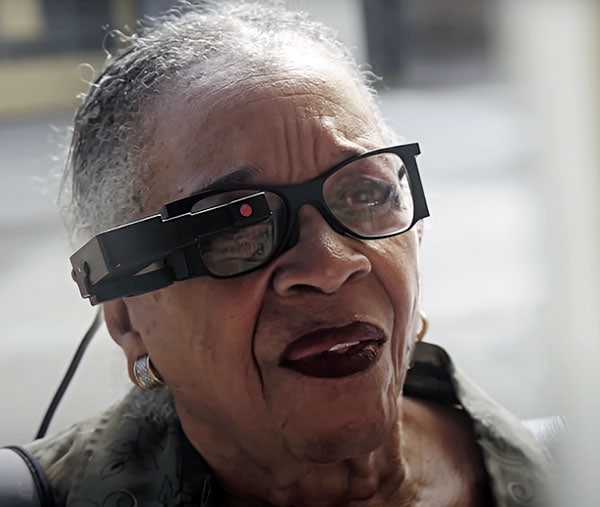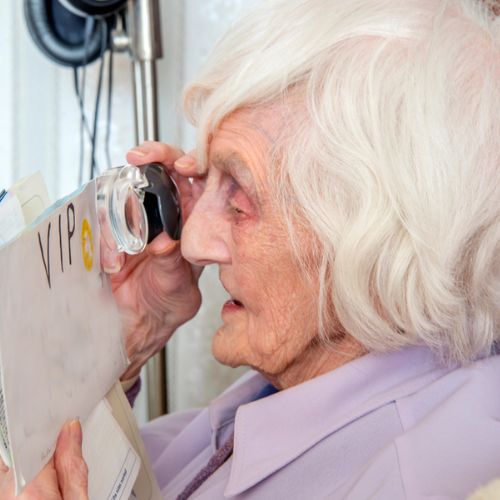A tiny wireless chip and specialized glasses help legally blind patients read again
At Assil Gaur Eye Institute, we are committed to informing our patients about the latest breakthroughs in vision care. A pioneering new technology offers renewed hope for patients with geographic atrophy, the most advanced stage of dry age-related macular degeneration (AMD).
According to a study published Monday in the New England Journal of Medicine, a small wireless chip implanted in the back of the eye, along with specialized augmented reality glasses, has allowed patients with advanced macular degeneration to read again.

Understanding geographic atrophy and AMD
The trial involved 38 European patients, all of whom had geographic atrophy—the advanced stage of dry AMD. Currently, there is no cure for AMD, which results from changes in the macula (a part of the retina) and is caused by inflammation and a buildup of waste materials.
The photoreceptor cells in the macula create sharp, detailed, and colored vision. As the disease advances to geographic atrophy, these cells break down and die, leading to a loss of central vision. Objects directly ahead may look blurry or be obscured by a dark spot.
According to the American Macular Degeneration Foundation, about 22 million people in the United States have AMD, and roughly one million have advanced to geographic atrophy.
How the PRIMA device works
In the study, participants with an average age of 79 were fitted with the “PRIMA device,” a system designed to replicate vision. Here’s how it works:
- The augmented reality glasses: Patients wear specialized glasses embedded with a camera that captures their visual field.
- The implanted chip: What the camera “sees” is transmitted as infrared light to a tiny chip implanted in the back of the eye.
- Signal conversion: The chip converts the light into an electrical current, which stimulates the remaining healthy cells in the macula.
- Brain interpretation: The brain then processes these electrical signals as vision.
An image processor that patients must carry allows users to zoom in and magnify the images they view. The images are displayed in black and white instead of full color.
Remarkable results from the clinical trial
With the help of the PRIMA device, 80% of the 32 patients who returned for reassessment one year after chip implantation experienced meaningful visual improvements. This marks a significant breakthrough for a condition that previously lacked treatment options to restore lost vision.
“It’s the first-ever therapeutic approach that has led to an improvement in visual function in this group of patients,” said Dr. Frank Holz, the trial’s lead investigator and chair of the department of ophthalmology at the University Hospital of Bonn in Germany. “Late-stage age-related macular degeneration is a grim disease. Patients are no longer able to read, drive, watch TV, or even recognize faces. So these results are a game-changer in my mind.”
One patient, Sheila Irvine, 70, who received the PRIMA device in London, described her life before the implant as “having two black discs in my eyes, with the outside distorted.” A self-described “avid bookworm” before losing her vision, Irvine said she is now able to do crosswords and read prescriptions.
Understanding the risks and side effects

As with any surgical procedure, patients did experience some side effects. The study reported that 26 serious adverse events occurred in 19 patients, ranging from elevated eye pressure to blood accumulation around the retina. Most of these adverse events resolved within two months of implantation.
Dr. Demetrios Vavvas, director of the retina service at Mass Eye and Ear in Boston, who was not involved in the study, noted that the surgery requires a high level of skill and carries risks. “You have to lift the retina off its normal position to implant this device, which increases the atrophy,” explained Dr. Vavvas, highlighting the technical complexity of the procedure.
Current limitations and future potential
There are several significant limitations of the current technology. The device does not restore normal vision—patients can only see in black and white instead of color. Additionally, trial participants had to undergo extensive training to learn how to use the PRIMA device effectively. It is also still unclear whether the improvements in visual ability have notably enhanced patients’ overall quality of life.
However, doctors remain optimistic about the technology’s future. Think of this device as the pre-release iPhone. The limitations are clear, and we shouldn’t oversell the improvement in quality of life. But there were certain [visual] tasks at which the patients were clearly better. So, it shows that there is potential in this approach.
Exciting advances on the horizon
Stanford University ophthalmology professor Daniel Palanker invented the PRIMA system and is being developed by Science Corporation, a California-based neural engineering company. New upgrades could be coming in the next couple of years.

Dr. Palanker said technical improvements are underway to increase the number of pixels in the chip from 400 to 10,000. The new chips have already been tested in rats, and upgraded versions are being manufactured for future human trials. With the aid of the camera’s zoom function, this could theoretically enable patients to achieve 20/20 visual resolution.
“We are also working on next-generation software that will allow patients to perceive not just black-and-white text, but also grey-scale natural images, such as faces,” Dr. Palanker explained.
The technology may also be trialed in other retinal diseases that cause blindness, such as Stargardt disease, which has similar symptoms to AMD but is genetic and usually affects younger people.
What comes next
While experts agree the device isn’t a complete solution for blindness yet, the study demonstrates that brain-computer interfaces represent an important approach to tackling severe visual impairment. As this device improves, it could become a real solution for some patients.
Schedule your consultation today with the internationally recognized doctors at AGEI
Or call
866-945-2745
Our commitment to advanced macular degeneration care
At Assil Gaur Eye Institute, our retina specialist, Dr. Svetlana Pilyugina, and team of ophthalmologists remain at the cutting edge of ophthalmological research and treatment. Although the PRIMA device is still in clinical trials and not yet available in the United States, we are closely monitoring this and other promising technologies that could benefit our patients with geographic atrophy.
If you have questions about your macular degeneration diagnosis or treatment options, or any other eye condition or treatment, we encourage you to discuss them with our doctors. We’re here to provide you with the most current information and the highest quality care.
Sources
Subretinal Photovoltaic Implant to Restore Vision in Geographic Atrophy Due to AMD
The New England Journal of Medicine
Original NBC News article
Content adapted for patient education by Assil Gaur Eye Institute, Beverly Hills and Santa Monica, CA













